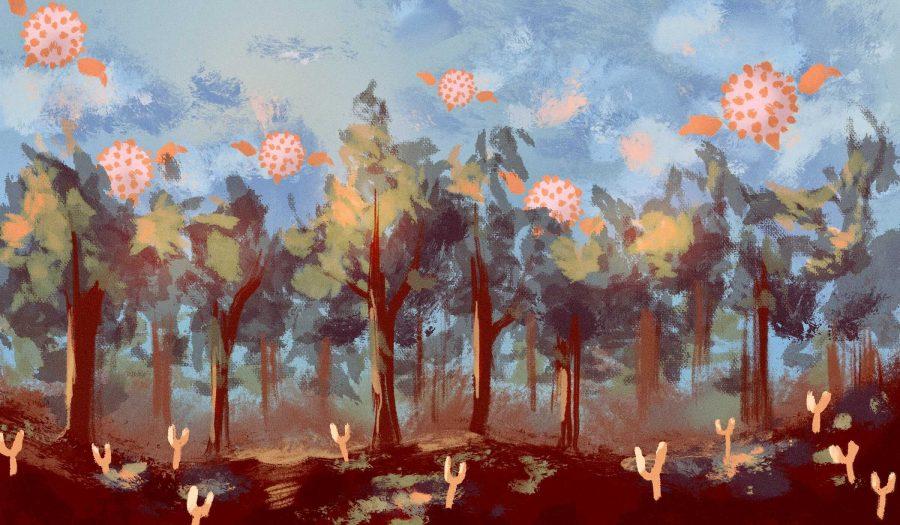A UC San Diego research team was recently featured by the National Institute of Health for discovering a compound called heparan sulfate and its role in COVID-19. Heparan sulfate is a natural component made by cells and is part of how the virus causes infection. If the levels of the compound can be effectively manipulated or blocked by the blood-thinning medication Heparin, researchers hope that this can become a staple treatment of the disease.
In an interview with The UCSD Guardian, visiting researcher Dr. Thomas Clausen of the University of Copenhagen in Denmark described the gravity of this breakthrough.
“What we’re developing is something that suggests that there will be a treatment for people that already have it,” Clausen said. “If that gets developed and you’re able to control the virus in a hospital setting for people who are infected then we could go back to normal.”
Ever since the beginning of the pandemic, scientists have been struggling to find a medicine that targets the replication of COVID-19. Regeneron is an antibody-cocktail going through clinical trials; Remdesivir is a widely used antiviral that is the current standard of care treatment of hospitalized patients with the virus; and vaccines, which are still undergoing many measures to be approved, could possibly decrease the chance of getting infected. All of these treatments are aiming to prevent further infection.
“[We are] competitive with a common goal of solving a pandemic… it’s inspiring, it’s humbling, it’s life-changing in many ways,” said Dr. Jeff Esko, a UCSD Professor of Cellular and Molecular Medicine.
The UCSD research team has discovered a treatment that could prevent infection of cells throughout the human body.
The blood-thinner Heparin is administered so as to prevent blood-clots, but can also block viruses from binding to heparan sulfate on the cells’ outer membrane. This characteristic could prevent the virus from making it into the cell and multiplying. Heparin has the potential to stave off the virus within patients already infected, leading to saving thousands of lives.
Dr. Esko has an apt analogy to describe the SARS-CoV-2 infection process. He describes the glycocalyx, a thin layer of proteins and carbohydrates surrounding our cells, as “a forest.” The various substances are dubbed as “the trees and the bushes above the cell.”
In Dr. Esko’s analogy, the infectious SARS-CoV-2 virus, which causes COVID-19, is represented as birds flying high above the trees to find and catch the worm, which is its preferred cell receptor ACE2, down on the cell’s surface. Put simply, COVID-19 needs to use specific substances in the outer layer of our cells to invade and replicate within them.
Heparan sulfate is the preferred cellular carbohydrate present within the glycocalyx for the virus to utilize. The physical spikes on SARS-CoV-2 interact with Heparan sulfate on cells and make their way to the ACE2 receptors, allowing for further replication.
Researchers discovered a codependent relationship between the virus and the glycan, or substance within the glycocalyx. This hints at the possibility of using non-anticoagulant derivatives, otherwise known as blood-thinners, to further conceal the body’s cells and prevent COVID-19 from spreading as quickly.
“In this case, SARS uses Heparan sulfate. And then, because Heparin is also used clinically as a drug, we can use it as a decoy,” said Daniel Sandoval, a Postdoctoral researcher on the team.
Heparin would be administered to patients already infected with the virus. No clinical trials have been held yet, but the National Institute of Health has used this discovery as a precedent for pursuing such endeavors.
Artwork courtesy of Angela Liang for The UCSD Guardian.















Carol • Nov 26, 2020 at 5:06 am
Basic research and innovation is vital to contain and mitigate the impact of the rapidly developing COVID-19 pandemic. In the ever-changing situation in which we find ourselves, it is important to have the latest information and it is important that it comes from reliable sources. Thank you for your research! I am increasingly confronted with the successful practice of stem cell autism treatment https://www.startstemcells.com/autism-treatment-therapy.html, a comprehensive approach to autism treatment gives patients a better chance to improve their quality of life.
Kim Ruiz • Oct 20, 2020 at 7:57 am
New and informative! Haven’t heard of this possibility yet. I think Dr. Zach Bush has highlighted that COVID may need to be treated as a blood poisoning. Much like cyanide poisoning due to hypoxia and other symptoms with the blood.
Great highlighting in such a way that we are informed! Good going!
Mary Vink • Oct 19, 2020 at 3:19 pm
This was a very well written article. Nice job!
Ron Ruiz • Oct 19, 2020 at 1:52 pm
Amazing what great work!!
Great Article!!
Diana Zay Blaney Silva • Oct 19, 2020 at 1:38 pm
Very informative. I hope it works.